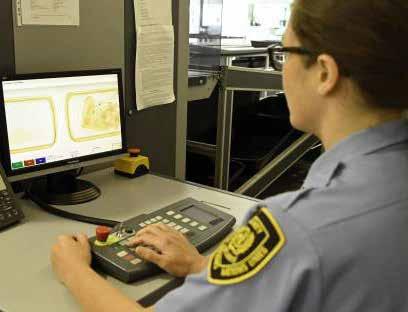
3 minute read
UAE combats climate change with nuclear power and shares its experience
By Michael Amdi Madsen
By anyone’s standards, the United Arab Emirates (UAE) is a hot place to be in the summer. Temperatures during that season are regularly in the 40-degree Celsius range and, on occasion, exceed the 50-degree mark. Climate change is exacerbating the situation. The country of almost 10 million people, is categorized among those with the highest rate of vulnerability to climate change impacts, with warmer weather, less rain, droughts, higher sea levels and more storms expected. Keeping the country habitable in the long term means addressing climate change.
One way the UAE is addressing climate change is by reducing the carbon footprint of its energy system with nuclear power — a strategy that, through cooperation with the IAEA, it is helping to replicate in other countries.
In 2007, after careful consideration, the UAE decided to develop a civilian nuclear energy programme. Just eight years after construction began in 2012, a nuclear power reactor of South Korean design, the first in a series of four, was connected to the UAE grid. The new nuclear power plant situated in Barakah, almost 300 kilometres west of the country’s capital, Abu Dhabi, is the first in the Arab world.
“Many countries are pursuing new nuclear power programmes, but the UAE is special in successfully kick-starting a programme and realizing commercial nuclear energy in such a short time, with all of the safety standards and regulations we expect today,” said Francois Foulon, Professor, Chair of Nuclear Engineering and Director of the Emirates Nuclear Technology Center at Khalifa University.
Foulon works closely with the IAEA in coordinating activities where experts from other countries can visit and learn from the UAE’s experience. In this capacity, Khalifa University has been designated an IAEA Collaborating Centre for nuclear energy infrastructure and human resources since 2017.
“When the UAE embarked on its nuclear programme, it started with limited infrastructure and capabilities: very few nuclear engineers, no nuclear experience, nuclear legislation nor comparable role models for such a large project,” Foulon explained. “The country has had to build almost all of this from scratch. The IAEA helped along the journey, so now the country is giving back and sharing its experiences to help others realize their nuclear power ambitions.”
Decarbonizing energy in the UAE and beyond
Major drivers for the UAE to pursue nuclear power have been its reliability, 24-hour availability, and baseload low carbon power, Foulon said. Low carbon nuclear power is critical for the country as it pursues a 2050
‘net zero’ strategy that aims for 14 gigawatts of clean energy capacity by 2030.
Barakah is contributing to this with two units currently in commercial operation, the third one in the process of starting up and the fourth in the final steps of commissioning. Once its four reactor units are complete, they could deliver up to a quarter of the UAE’s electricity. The Emirates Nuclear Energy Corporation (ENEC) expects the plant to produce up to 5600 megawatts of electricity — enough to power 574 000 households in the country for a whole year. They say this will prevent the release of 22.4 million tonnes of carbon emissions annually, the same amount of carbon 350 million trees would absorb over 10 years. This is also equivalent to a quarter of the UAE’s emissions reduction pledge submitted to the United Nations climate conference, COP26, in 2021.
Other countries are also interested in harnessing nuclear power for its climate change mitigating power, and today around 30 countries are considering embarking on nuclear power. With the support of the IAEA, the Khalifa University Collaborating Centre is sharing its know-how with some of those countries.
“The UAE’s nuclear power plant development experiences have become a shining light on the hill for all newcomer nations; the lessons are clear and amazing,” said Kufre Friday Akpan, Principal Scientific Officer at the Nigeria Atomic Energy Commission. In 2019, he took part in the IAEA’s Nuclear Power Infrastructure
Development School on implementing national requirements for nuclear programmes, hosted in the UAE. The experience gave him the opportunity to visit the UAE and meet and learn directly from experts from the UAE’s Federal Authority for Nuclear Regulation (FANR) and ENEC.
“The Khalifa University Collaborating Centre gives experts from the around the world the opportunity to learn from the UAE’s experiences and its pathway towards nuclear power,” said Liliya Dulinets, Head of the IAEA’s Nuclear Infrastructure Development Section. She works closely with the Centre to organize training events in the country and maximize the lessons others can learn. Over the years, the Collaborating Centre has organized numerous training events, including a course on nuclear education and human resource development for nuclear embarking countries such as Malaysia, Saudi Arabia and Viet Nam.
Dulinets said the UAE’s hosting of the International Ministerial Conference on Nuclear Power in the 21st Century in 2017 was a springboard for greater visibility of the country’s nuclear success. In 2023, the country will be in the global spotlight as it hosts COP28 in Dubai. Dulinets is now coordinating with the Collaborating Centre to further enhance cooperation and implement specific training courses for newcomer needs. “As the global climate crisis worsens, the need for new nuclear power is growing. The world can learn from the lessons of the UAE and ensure a decarbonized future.”
Glaciers in Switzerland lost more than six per cent of their volume in 2022, the worst year on record.






